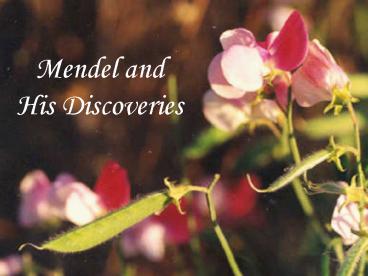Mendel and His Discoveries - PowerPoint PPT Presentation
1 / 20
Title:
Mendel and His Discoveries
Description:
Title: PowerPoint Presentation Author: J S Last modified by: Jannette Created Date: 2/11/2004 4:36:24 PM Document presentation format: On-screen Show – PowerPoint PPT presentation
Number of Views:100
Avg rating:3.0/5.0
Title: Mendel and His Discoveries
1
Mendel and His Discoveries
2
Gregor Mendel
- An Austrian monk, who knew nothing about genetics
or - First person to understand how living things
passed on their traits - Worked with peas
3
11.1 Mendel and the Black Box
- Black box wanted to understand genetics without
being able to look inside the box - The input for his box? pea plants and the output
? offspring - The unknown was the genetic events that occurred?
DNA, chromosomes and Meiosis
4
Mendel was able to infer what was going on within
- Basic units of genetics are material elements
- Elements come in pairs
- These elements (genes) can retain their character
through many generations - That gene pairs separate during the formation of
gametes
5
11.2 The Experimental Subjects Pisum sativum
- Pisum sativum
- Perfect for the experiment
- Self pollinate
- Cross pollinate
- He could pollinate individual plants
- Enabled him to control certain attributes?
characters - Yellow pea, wrinkled pea, purple flower
- Table 11.1
- Represents different characters
- Each character comes in two varieties? traits
- Yellow or green, round or wrinkled
- Each was either dominant or recessive
- Dominant ? appears in a generation
- Recessive? remains hidden within the generation
6
Phenotype and Genotype
- Traits represent ? phenotypes
- visible characteristics
- Physical feature
- Bodily characteristic
- Behavior of an organism
- White flower, yellow seeds
- Genotype
- Genetic make up
- What determines phenotype
- Represented as letters
- Yyellow
- y green
7
11.3 Starting the Experiments Yellow and Green
Peas
- true breeding
- Needed to assure that only one specific trait was
present in the offspring - Yellow pea? Parents ALL yellow pea offspring
8
Parental, F1, and F2 generation
- P generation? parental generation
- F1? first filial generation? the offspring of the
parental generation - F2? any succeeding generations
- How did Mendal proceed with his plants
- Two true breeding plants
- Yellow peas?P
- Green peas?P
- Cross fertilized
- F1 generation yellow? dominant color
- He then took the F1 generation and
self-pollinated them - F2 generation? 31 ratio yellow/green
- 6,022 yellow and 2,001 green
9
(No Transcript)
10
- Interpreting F1 and F2 results
- NO blending
- Flower colors do not mix
- Dominant and recessive elements come in pairs
11
Another Generation for Mendel
- F2 generation? self-fertilized
- F3 generation?
- Pure yellow? yellow
- Mixed yellow? yellow
- Pure Green? green
12
The Law of Segregation
- Two copies of a character (allele) are carried by
each plant - They must separate in gamete formation
- The recombine in different ways
- Mendel's first Law of Segregation? different
characters in organisms result from two genetic
elements (alleles) that separate in gamete
formation, such that each gamete gets one of the
two alleles
13
Homozygous and Heterozygous Conditions
- Pure? Homozygous
- Two identical alleles for a given character
- YY? Homozygous dominant
- yy? Homozygous recessive
- Mixed ? Heterozygous
- An organism that has different alleles for a
given character - Yy? Heterozygous Dominant
- Dominant? allele expressed
- Recessive? allele not expressed in the
heterozygous condition
14
Crosses for Seed Color and Seed Shape
- Dihybrid cross
- Indicated that
- Seed shape and seed color independently assorted
- Proved that
- one character did not affect the other
15
(No Transcript)
16
11.7 Incomplete Dominance
- What Mendel discovered in his peas? does not
apply to all organisms - Example Flower color never mixed in Mendels pea
plants - Purple PP x White pp Purple Pp
- Other plants results are different
- Red-flowered Snapdragon
- Red RR x White rr Pink Rr
- Only one red allele produces enough pigment to
make the plant pink
17
11.8 Lessons From Blood Types Codominance
- Blood type? Types of Protein that covers the
surface of red blood cells - Type A blood? Both Alleles A
- Type B Blood? Both Alleles B
- Type AB blood? One Allele A the other B
- Type O Blood? Does not code for any surface
proteins - Type AB do not get half the expression like the
red-flowered snapdragon - Both alleles are expressed which results in
codominance? - A condition in which two alleles of a given gene
have different phenotypic effects, with both
effect manifesting in organisms that are
heterozygous for the gene
18
11.9 Multiple Alleles and Polygenic Inheritance
- Alleles can come in many variations
- Multiple alleles? three or more alleles of the
same gene exist in a population - Traits are controlled by one gene in Mendels
peas - Most traits are governed by many genes
- Height
- Weight
- Eye color
- Polygenic inheritance? the inheritance of a
genetic character that is determined by the
interaction of multiple genes, with each gene
having a small additive effect on the character - Continuous variation? range
- Bell curve? a distribution of values that is
symmetrical and largest around the average
19
11.10 Genes and Environment
- Environmental factors? any external influence
that is favorable or unfavorable for the
development of a trait in an organism - Hydrangeas
- Change color depending on soil composition
- Other examples during winter many animals change
their fur coats - Fox
- Hare
20
(No Transcript)

